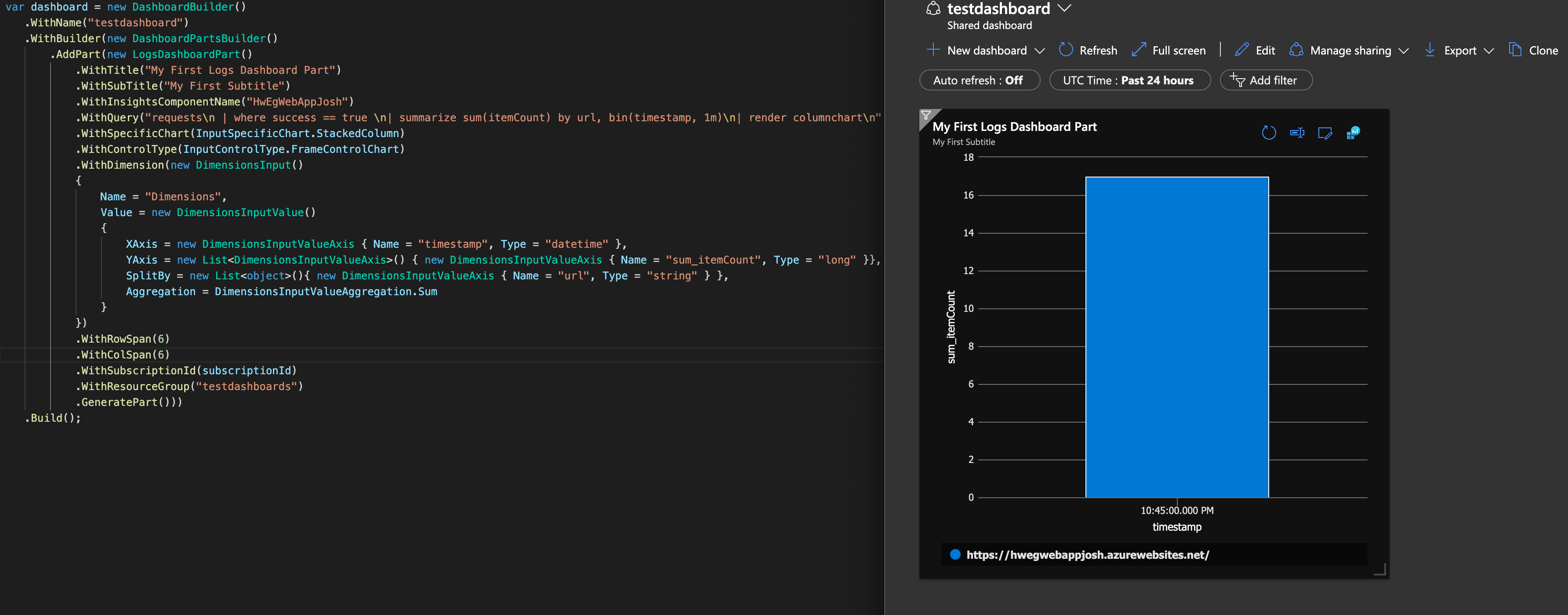A fluent dotnet/core SDK to generate Azure Dashboards
Kustomaur.Builder is available on Nuget: https://www.nuget.org/packages/Kustomaur.Builder/
// use the dashboard builder to start creating a dashboard
var dashboard = new DashboardBuilder()
.WithName(name) // give it a name
.WithBuilder(new DashboardPartsBuilder() // to add parts, use a DashboardPartsBuilder
.AddPart(new LogsDashboardPart() // this adds a LogsDashboardsPart (from Log Analytics)
.WithTitle("My First Logs Dashboard Part")
.WithSubTitle("My First Subtitle")
.WithInsightsComponentName("HwEgWebAppJosh") // this is the name of the Application Insights log analytics resource
.WithQuery("requests\n| where success == false\n| render barchart\n") // the Kusto query you want to execute
.WithSubscriptionId(subscriptionId) // the subscriptipn ID of where this should be
.WithResourceGroup(resourceGroup) // the resource group of where this should be
.GeneratePart())) // Generates a DashboardPart to be given to the builder
.Build(); Tells the DashboardBuilder to build the final Dashboard object
// Generate the JSON with just the main properties (useful if you just need the JSON and want to deploy it via CLI / REST / Other deployment methods (e.g. Terraform)
var dashboardPropertiesJson = Generator.Generate(dashboard.Properties);
// Generats JSON for whole dashboard:
var dashboardJson = Generator.Generate(dashboard);* currently Kustomaur does not support the ability to automatically create the dashboard in Azure, as it simply a JSON generation library - but this missing functionality is coming soon in Kustomaur.Azure!!!!
Kustomaur is built with 2 layers:
- Kustomaur.Models: POCOs representing the JSON classes in Azure Dashboards
- Kustomaur.Builders: A set of fluent builders using higher level concepts to create & configure Azure Dashboards, which then produces a Kustomaur.Models.Dashboard object
A third layer of Kustomaur.Azure will add further Azure Portal functionality to be able to create the dashboard and make it available in the portal
Current Dashboard Parts that are supported:
| Name | Description | Example(s) |
|---|---|---|
| ApplicationMapPart | Generates an application map for the ApplicationInsights ID that is set for this part | ApplicationMapTests |
| LogsDashboardPart | This is a part that can be added to dashboard that stems from a Azure Log Analytics - a Kusto query can be set as well as defining the dimensions and rendering options | LogDashboardTests |
| MarkdownPart | Part which allows to create markdown | Simple Dashboard with Markdown |
| MonitorChartPart | This part allows the display of a Monitor chart, for example the machine stats in a serverFarm | MonitorChartPartTests |
Other parts will be supported in future, but for ones that are not, new ones can be easily added by inheriting: DashboardPart class.
Adding multiple parts in a single row or column is straight forward with Kustomaur.
In order to add multiple parts in a single row can be done as a single list:
var dashboard = new DashboardBuilder()
.WithSubscription(subscriptionId)
.WithResourceGroup(resourceGroup)
.WithName(name)
.WithBuilder(new DashboardPartsBuilder()
.AddPartsAsRow(new List<Part>()
{
new MarkdownPart(content:"# my first part in 1st row")
.WithColSpan(3)
.GeneratePart(),
new MarkdownPart(content:"# my second part in 1st row")
.WithColSpan(3)
.GeneratePart()
})
.AddPartsAsRow(new List<Part>()
{
new MarkdownPart(content:"# my first part in 2nd row")
.WithColSpan(4)
.GeneratePart(),
new MarkdownPart(content:"# my second part in 2nd row")
.WithColSpan(4)
.GeneratePart()
})
.Build();The same can be done as adding multiple parts in a column:
var dashboard = new DashboardBuilder()
.WithSubscription(subscriptionId)
.WithResourceGroup(resourceGroup)
.WithName(name)
.WithBuilder(new DashboardPartsBuilder()
.AddPartsAsColumn(new List<Part>()
{
new MarkdownPart(content:"# my first part in 1st column")
.WithRowSpan(3)
.GeneratePart(),
new MarkdownPart(content:"# my second part in 1st column")
.WithRowSpan(3)
.GeneratePart()
})
.AddPartsAsColumn(new List<Part>()
{
new MarkdownPart(content:"# my first part in 2nd column")
.WithRowSpan(4)
.GeneratePart(),
new MarkdownPart(content:"# my second part in 2nd column")
.WithRowSpan(4)
.GeneratePart()
})
.Build();This can also be done in combination:
var dashboard = new DashboardBuilder()
.WithSubscription(subscriptionId)
.WithResourceGroup(resourceGroup)
.WithName(name)
.WithBuilder(new DashboardPartsBuilder()
.AddPartsAsColumn(new List<Part>()
{
new MarkdownPart(content:"# my first part in 1st column")
.WithRowSpan(3).WithColSpan(2)
.GeneratePart(),
new MarkdownPart(content:"# my second part in 1st column")
.WithRowSpan(3).WithColSpan(2)
.GeneratePart()
}, out int firstColumnMaxX) // firstRowMaxY is what we should set the new row Y value
.AddPartsAsColumn(new List<Part>()
{
new MarkdownPart(content:"# my first part in 2nd column")
.WithRowSpan(4).WithColSpan(2)
.GeneratePart(),
new MarkdownPart(content:"# my second part in 2nd column")
.WithRowSpan(4).WithColSpan(2)
.GeneratePart()
}, out int secondColumnMaxX, startXPos:firstColumnMaxX)
.AddPartsAsColumn(new List<Part>()
{
new MarkdownPart(content:"# my first part in 3rd column")
.WithRowSpan(5).WithColSpan(2)
.GeneratePart(),
new MarkdownPart(content:"# my second part in 3rd column")
.WithRowSpan(5).WithColSpan(2)
.GeneratePart()
}, out int thirdColumnMaxX, startXPos:secondColumnMaxX)
.AddPartsAsRow(new List<Part>()
{
new MarkdownPart(content: "# my first part in the 4th column - as 1st row")
.WithX(thirdColumnMaxX)
.WithRowSpan(10).WithColSpan(6)
.GeneratePart(),
new MarkdownPart(content: "# my second part in the 5th column - as 1st row")
.WithX(thirdColumnMaxX)
.WithRowSpan(10).WithColSpan(6)
.GeneratePart()
}, out int firstRowMaxY)
.AddPartsAsRow(new List<Part>()
{
new MarkdownPart(content: "# my first part in the 4th column - as 2nd row")
.WithX(thirdColumnMaxX)
.WithRowSpan(10).WithColSpan(6)
.GeneratePart(),
new MarkdownPart(content: "# my second part in the 5th column - as 2nd row")
.WithX(thirdColumnMaxX)
.WithRowSpan(10).WithColSpan(6)
.GeneratePart()
}, out int secondRowMaxY, startYPos: firstRowMaxY)
)
.Build();You will notice that AddPartsAsRow() has an overload which has an out parameter, which is set to the large Y position out of all of the parts in the row. This value can be used incase new parts were to be added underneath the row (not using another AddPartAsRow()). The same logic applies to AddPArtsAsColumns where the out parameter is set to the value of the component with the largest width/X value.
Currently, it is suggested (here: Azure Portal Dashboards Create Programmatically), that the programmatic generation of an Azure Dashboard starts off with creating the dashboard by hand within the Azure Portal, exporting it as JSON, converting to a template (with parameters by hand), and then using a deployment method via CLI/Powershell/REST API to upload the template.
Whilst this is a good idea for initially creating a dashboard, this becomes difficult to maintain when wanting to create small changes, as this process has to be repeated:
- prone to error when converting JSON to a template with parameters by hand
- reviews of large blobs of JSON is difficult
- a small change (like adding a new part), can cause lots of changes across the whole dashboard which is difficult to maintain
- not fully automated
